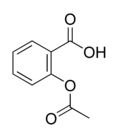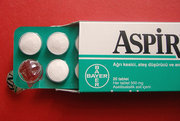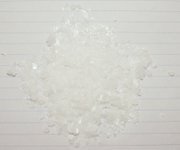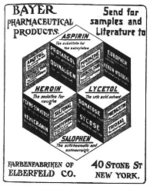Clinical Questions
What is the risk of stroke in a patient with nonvalvular atrial fibrillation, and should that patient be given warfarin (Coumadin) or aspirin?
Evidence Summary
Pooled data from randomized trials show that warfarin reduces the risk of stroke from 4.5 percent to 1.4 percent per year in patients with nonvalvular atrial fibrillation and no history of stroke or tran-sient ischemic attack (TIA). Approximately one half of these strokes are moderate, severe, or fatal. (1) Warfarin increases the risk of major hemorrhage from 1.0 percent to 1.3 percent per year and increases the risk of intracranial hemorrhage from 0.1 per-cent to 0.3 percent per year. Therefore, at the Seventh Conference on Antithrombotic and Thrombolytic Therapy, the American College of Chest Physicians (ACCP) recommended warfarin for atrial fibrillation patients at high risk of stroke, aspirin for patients at low risk of stroke, and either drug of patients with an intermediate risk. (1) The ACCP defines a low-risk patient as younger than 65 years with no predisposing risk factors (e.g., previous stroke, TIA, embolism, heart failure, hypertension, diabetes).
A clinical rule regarding warfarin and aspirin treatment for stroke patients was recently proposed by van Walraven and colleagues. While promising, it has not been prospectively validated in a new population. (2) The ACCP rule and several other clinical decision rules have been prospectively validated in new populations of patients, which is the best way to evaluate a clinical decision rule (see Tables 1 and 2 online at http://www.AAFP.org/AFP/20050615/poc.html for a summary of data). (3-5) Pearce and colleagues (3) used data from Stroke Prevention in Atrial Fibrillation (SPAF) III, a randomized trial that evaluated three rules by studying the effects of aspirin versus the effects of warfarin. A 2001 study by Gage and colleagues4 used data from a national registry of Medicare patients with atrial fibrillation who were discharged from the hospital but not given warfarin (only 31 percent were receiving aspirin). Because most patients with atrial fibrillation who are not candidates for warfarin should be taking aspirin, the most appropriate study population for evaluation of these clinical decision rules includes patients who have no history of stroke and who are receiving aspirin. Therefore, the 2004 study by Gage and colleagues (5) used data from the aspirin-only arms of five prospective clinical trials, including SPAF-III, (2) and involves most of the same patients studied by Pearce in 20003; therefore, recommendations in this Point-of-Care Guide are based on data from Gage's 2004 validation study (5) and the ACCP guideline. (1) The overall risk of stroke in both studies was 2.5 percent. Approximately one third of patients in these studies were women, the mean age was approximately 70 years, and all patients were receiving aspirin.
All five rules evaluated in the study effectively identify low-risk patients (i.e., patients with 0.5 to 1.4 strokes per 100 patient-years). This risk is similar to that seen in studies of patients taking aspirin alone. However, the rules vary considerably regarding the percent-age of patients falling into the low-risk group. The most useful rule would accurately classify the largest possible percentage of patients as low risk so that as many patients as possible can avoid the inconvenience, cost, and risk of oral anticoagulation with warfarin. The ACCP and Atrial Fibrillation Intervention (AFI) rules only classify 9 percent and 12 percent of patients as low risk, respectively. Combining the ACCP's low- and moderate-risk groups yields a larger 23 percent of patients with an annual stroke risk of 0.85 percent. The Framingham rule identified the largest percentage of patients at low risk (49 percent) but they had a fairly high annual risk of stroke (1.4 percent). Between these extremes was the Stroke Prevention in Atrial Fibrillation (SPAF) rule, which classified 33 percent of patients as low risk (1.1 percent annual stroke risk), and the CHAD[S.sub.2] rule (named for the components of the score: congestive heart failure [past or present], hypertension [at least 160/90 mm Hg, past or present], age [older than 75 years], diabetes, and stroke or transient ischemic attack [past or present]), which classified 23 percent of patients as low risk (0.8 percent annual stroke risk).
Figure 1 shows the ACCP and CHAD[S.sub.2] rules and their interpretations. Physicians may choose to use either rule or both in conjunction. By using more than one rule, the physician and patient may be more confident in a low- or high-risk assignment if the rules are consistent. When patients are at intermediate risk or when the risk assessment is inconsistent between the rules, the physician may evaluate the patient's risk of bleeding while taking warfarin before making a decision. While there is no definitive rule to determine the risk of bleeding in patients receiving anticoagulation therapy because of atrial fibrillation, one has been developed and validated in 222 patients receiving long-term anticoagulation for venous thromboembolism (mean follow-up 18 months). (6) In this study, there were five cases of major hemorrhages, all in patients classified as moderate or high risk of bleeding. Therefore, patients who have intermediate risk of stroke and low risk of bleeding may be good candidates for oral anticoagulation. For additional guidance on initiating and adjusting oral anticoagulation with warfarin, please see two recent articles in this Point-of-Care Guides series. (7,8)
Applying the Evidence
Mrs. G. is a 67-year-old woman with atrial fibrillation but no history of stroke. She has well-controlled diabetes but does not have known heart disease or hypertension. She is not anemic and has no history of gastrointestinal bleeding. Should she be treated with aspirin or warfarin to reduce her risk of stroke?
Answer. Based on the ACCP rule, she is high risk, because she has two of the moderate risk factors (i.e., she is older than 65 years and has diabetes). She has one point from the CHADS2 score that also places her at moderate risk. Her risk of bleeding is higher than average because of her diabetes and age. You discuss the risks and benefits of treatment with her, and her biggest concern is having a stroke that might leave her disabled. You institute warfarin for her, using the guidelines for initiation and monitoring described in two previous Point-of-Care Guides. (7,8)
REFERENCES
(1.) Singer DE, Albers GW, Dalen JE, Go AS, Halperin JL, Manning WJ. Antithrombotic therapy in atrial fibrillation: the Seventh ACCP Conference on Antithrombotic and Thrombolytic Therapy [Review]. Chest 2004;126(3 suppl):429S-56S.
(2.) van Walraven C, Hart RG, Wells GA, Petersen P, Koudstaal PJ, Gullov AL, et al. A clinical prediction rule to identify patients with atrial fibrillation and a low risk for stroke while taking aspirin. Arch Intern Med 2003;163:936-43.
(3.) Pearce LA, Hart RG, Halperin JL. Assessment of three schemes for stratifying stroke risk in patients with nonvalvular atrial fibrillation. Am J Med 2000;109:45-51.
(4.) Gage BF, Waterman AD, Shannon W, Boechler M, Rich MW, Radford MJ, et al. Validation of clinical classification schemes for predicting stroke: results from the National Registry of Atrial Fibrillation. JAMA 2001;285:2864-70.
(5.) Gage BF, van Walraven C, Pearce L, Hart RG, Koudstaal PJ, Boode BS, et al. Selecting patients with atrial fibrillation for anticoagulation: stroke risk stratification in patients taking aspirin. Circulation 2004;110:2287-92.
(6.) Wells PS, Forgie MA, Simms M, Greene A, Touchie D, Lewis G, et al. The outpatient bleeding risk index: validation of a tool for predicting bleeding rates in patients treated for deep venous thrombosis and pulmonary embolism. Arch Intern Med 2003;163:917-20.
(7.) Ebell MH. Evidence-based initiation of warfarin (Coumadin). Am Fam Physician 2005;71:763-5.
(8.) Ebell MH. Evidence-based adjustment of warfarin (Coumadin) doses. Am Fam Physician 2005;71:1979-82.
MARK H. EBELL, M.D., M.S., is in private practice in Athens, Ga., and is associate professor in the Department of Family Practice at Michigan State University College of Human Medicine, East Lansing. He also is deputy editor for evidence-based medicine of American Family Physician.
Address correspondence to Mark H. Ebell, M.D., M.S., 330 Snapfinger Dr., Athens, GA 30605 (e-mail: ebell@msu.edu). Reprints are not available from the author.
COPYRIGHT 2005 American Academy of Family Physicians
COPYRIGHT 2005 Gale Group




